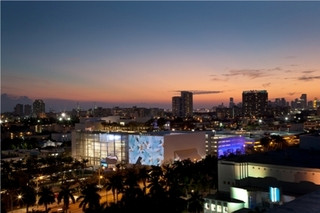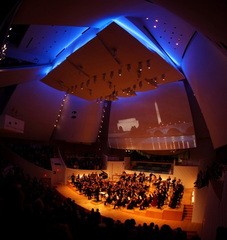|
Back
The New World Symphony (Part 1)
03/29/2015

New World Center from the Air(© Claudia Oribe)
In exactly one month, on April 28, the New World Symphony, conducted by Michael Tilson Thomas, will be appearing at Carnegie Hall. What exactly is this group? A trip to Miami Beach to their headquarters proved enlightening. And following is the first of two articles describing the architecture and the musical goals of Miami’s New World Center. A description of the musical goals under Michael Tilson Thomas continues tomorrow.
*****************************************
Wolfgang von Goethe described music as “liquid architecture” and architecture as “liquid music.” That’s easy enough for a poet to say. But how would Germany’s great bard describe architecture which is created for musicians, who–in the middle of Miami Beach, Florida–don’t even know what the word “frozen” means?
That building, the New World Center, was designed by the world-famous architect Frank Gehry, and he had a unique challenge when his friend, and fellow artist, Michael Tilson Thomas, put his own hand (holding his own baton) in the mixture. Mr. Thomas knew exactly who would inhabit this building–young orchestral musicians. And Mr. Gehry understood that the New World Center couldn’t simply be another alleged masterpiece. This New World Center would be built with a multiplicity of faces.

WallCast at night(© World Redeye)
From the outside, the structure, on a quiet street in downtown Miami, would be unprepossessing during the day, almost...shall we say, invisible? But to the learnéd eye, the transparency is an illusion. The front of this building consists almost entirely of windows. And while this is unique, these windows were not designed as an aesthetic gimmick. They were designed to look into the business inside the building.
In other words. Nobody inside can take refuge from passersby outside. When the inhabitants are bowing, tootling, or strumming, the squarely built edifice looks like it is actually moving.
Then we have the nocturnal New World Center. The windows are dark, but on the east side is a great white wall–370 feet by 360 feet, a 7,000 square foot area in a two-acre public park. And on this is a projection for the hundreds of viewers from all sections of Miami: the tourist area, Little Havana, Little Haiti, and visitors coming from around the globe. They are sitting, standing, drinking (frequently Champagne as well as beer), awaiting something magical.
This magic is usually a concert either live from inside or a futuristic filming from the concert a night before.
What exactly is the meaning of the edifice, built by Frank Gehry with the inspiration of Michael Tilson Thomas?
In effect, it is supposed to be the “intersection of music and architecture”.
Frank Gehry’s usual modus operandi is to take charge after the client gives basic instructions. Yet he could hardly be his own boss when Maestro Tilson Thomas, the scion of three generations of musicians, a man who, for 70 years has been immersed in composing, performing and leading the world’s greatest orchestras, is also in charge.
Not that the two probably didn’t argue about the building. Tilson Thomas, though, gave his own directions:
“This is an extraordinary building, the beginning of a wonderful adventure and exploration. Not only are we marking a new era for this organization and giving our musicians an unrivaled facility in which to learn and achieve their potential, but we are also inviting everyone to experience classical music in a new kind of space—one that is designed to engage and to energize, and that will move people from around the world to think about music in new ways.”
The details of the design differ much from Frank Gehry’s usual audacious structures. The building is simply rectangular, six stories high, apparently made for offices. But the Gehry inspiration comes in two ways. First from those countless windows which show off every single rehearsal, conference and meeting room for every passerby.
In terms of design the building’s exterior portrays a quiet, almost tamed Frank Gehry. The rectangle shaped white building expresses Gehry’s well known bends and folds within its interior – glimpses of which are visible through the main entrance east facade 80 foot high glass curtain wall. You can’t simply look up or down, since rooms are jutting out from the walls, the staircases, the inner folds.
While the conductor had been visiting Miami since 1987 with the orchestra he had created–an ensemble that would actually “train” already proficient players for orchestral performance (see tomorrow’s story)–, the chance to have his own building was too good an opportunity to pass up. Thus, instead of a mere concert hall, this is deemed a “laboratory” for the way music can be taught, performed and experienced.
So, aside from the structure outside, it was built to encompass 24 individual rehearsal rooms, four ensemble rooms, and three percussion rooms. An upper terrace allows visitors to observe the activities without disrupting them, and offering an expansive view over the public park.
On the third floor, Gehry had made room for a pair of ensemble rooms, where master classes can be held for up to 25 musicians. What is called “The Flower” also had a video/audio editing suite, which is constantly improving, thanks to a coterie of visiting electronic/digital/recording people who visit from around America.
On the top floor is a music library, patrons’ lounge (yes, the center is a joint financial arrangement between Miami, Dade Country and private patrons), and a rooftop garden.
But the rehearsal rooms too are wired for audio and video recordings, as well as the most advanced Internet presentations.
The latter makes it possible for, say, a young violinist to perhaps have a fingering problem, so she can immediately locate a First Chair player from the New York Philharmonic or Tilson Thomas’ own San Francisco Orchestra, to solve any digital conundrum.
All of these rooms–many of which can be seen from the entrance hall, hanging over the staircases, jutting out from the walls–are the preludes to the futuristic performing hall.

The Concert Hall (© Tomas Loewy)
It is difficult to describe this hall, for the simple reason that is has so many incarnations. The 7,000-square-foot auditorium has tiers of seats which can rise in any number of configurations. Nearly 800 listeners can enter from the two narrow corridors which wind from each part of the lobby, but they are usually in for a surprise.
While the hall is trapezoidal in form, the stage, the seating, the wings can make at least 14 different configurations. Depending on how the wings go, how the tiers can be raised or put flat on the floor, and even the use of four satellite platforms, the stage can be utilized for everything from opera to, what I saw, four different premieres, conducted by a student, introduced by Mr. Thomas himself.
In fact, for the configuration for the evening I attended, seven different screens were pulsing with mammoth visionary pictures for a work to commemorate the founding of Miami Beach itself.
Most important, especially for Mr. Thomas, not a single seat in the auditorium is more than 13 rows from the stage. The word “intimate” is tossed around too much, but to be in a large auditorium, where one can see every face, every bow movement, and (with the right seat) every grimace from the conductor is a very special experience.
Those wings on the side are called “sails” (whether this is a technical term or not I don’t know), and, from my point of view, the projections on these sails–different projections for different sails, varied lighting, images bouncing off each other–had as much interest at the music itself.
In other words, this may be one of the most innovative concert halls in America. Added to this, the nightly concerts in the balmy Miami air, where one can see even more of the Gargantuan stage with these screens, makes the New World concept, hidden by its momentarily drab exterior, both innovative and exciting.
*****************************************
Tomorrow, we ask who this building was built for. They aren’t “students”, it isn’t a permanent “orchestra”. The New World Symphony has a special jargon for its...its inhabitants.
Harry Rolnick
|